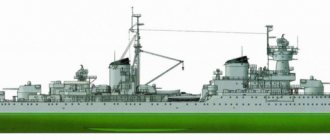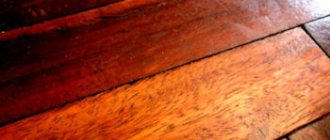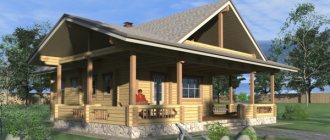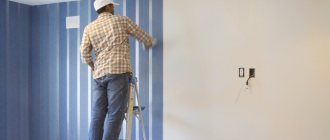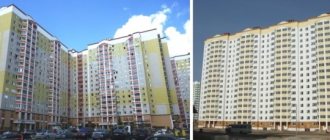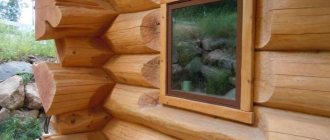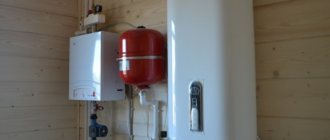Failed Soviet aircraft carriers: Project 72 in the face of problems
The further work on Project 72 progressed, the more unexpected problems faced Soviet engineers, and the more clearly they realized the depth of their ignorance of the “aircraft carrier” topic... As a result, the project was never implemented, and shipbuilders began designing a smaller aircraft carrier.
Aviators' opinion
On May 29, 1944, the leadership of the Navy Air Force reported to the Shipbuilding Directorate (UK) that neither it nor the Fleet Intelligence Directorate had sufficient materials to develop tactical and technical requirements for the aircraft carrier's aircraft armament. There were also no people familiar with the structure of foreign aircraft carriers - in connection with this, it was proposed to send a group of specialists to England and the USA to gain the necessary experience. Each group was to include two engineers from the design organizations of the People's Commissariat of the Shipbuilding Industry, one or two engineers from the Department of Shipbuilding and the Navy Air Force, one naval pilot and one specialist from the Main Naval Staff.
On June 30, the head of the Criminal Code N.V. Isachenkov approved this decision and said that the preliminary design project 72 is being considered by the fleet leadership and will be submitted for approval in July, therefore the conclusion of the Main Directorate of the Navy Air Force on its aircraft unit must be sent no later than July 10. In fact, this document arrived only on July 28, half a month late. It stated that:
“The preliminary design design of TsKB-17 is the first attempt to figure out the TTE [tactical and technical elements - approx. author] and aircraft weapons of a completely new class of ship for the USSR. The lack of technical requirements and operational materials for foreign aircraft carriers and the experience of their combat use in the current war at sea makes it extremely difficult to correctly resolve all issues, both for the contractor and the customer. Therefore, it is the development of a small aircraft carrier that makes the most sense.”
On this basis, the aviators actually avoided evaluating the project presented to them and limited themselves to general considerations for the design of aircraft carriers:
“This conclusion concerns only the main issues and is based on some information on aircraft carriers from foreign periodicals and discussions of some issues with representatives of the Navy Air Force.”
The conclusion of the Main Directorate of the Navy Air Force confirmed the opinion of TsKB-17 that it was inappropriate to place 45 aircraft on the ship due to the irrational use of hull volumes. It also noted that British and American aircraft carriers, similar in size to Project 72, have different aircraft capacities - for example, American Essex-class ships carry 100 aircraft each. It was explained like this:
“According to the English point of view, the aircraft carrier’s aircraft capacity is determined by the area of the hangars, since storing aircraft on the flight deck in stormy weather is excluded. The Americans also take into account the placement of aircraft on the flight deck in excess of the standard hangar capacity. It is not possible to establish which point of view is more correct and confirmed by the experience of the war.”
At the same time, it was pointed out that on foreign aircraft carriers some of the aircraft were stored disassembled, which made it possible to increase the composition of the air group. The need to provide space for aircraft repairs was also noted. It was proposed to determine the supply of fuel and aviation ammunition on the basis of two sorties per day over a five-day autonomous voyage.
American Essex-class aircraft carrier with aircraft on deck Source – navsource.org
In order to determine the dimensions of the takeoff and landing zones, as well as the optimal location of the “island,” it was necessary to conduct special studies of the take-off run and mileage of the torpedo bombers designed by plant No. 458. In addition, it was planned to test a mock-up of the flight deck at a land airfield at the Air Force Research Institute. The negative attitude of the aviators towards the deployment of universal artillery in the area of the “island” was especially noticeable - the pilots suggested leaving places here for temporary cleaning of aircraft after landing. The aviators also pointed out that “due to the lack of necessary information about the arresting device on foreign aircraft carriers, the question of its placement, as well as the size of the landing zone, remain open.”
It was proposed to consider only two types of aircraft as the main aircraft armament of an aircraft carrier: fighters and torpedo bombers. The deployment of auxiliary aviation was also allowed: communication aircraft, rescue, ambulance and even transport aircraft. It is characteristic that dive bombers were not mentioned at all! The optimal ratio of fighters to attack vehicles was assumed to be two to one, but it was indicated that it could vary depending on the specific mission. As for the small aircraft carrier, it was proposed to take into account the option of placing only fighters on it.
The Main Directorate of the Navy Air Force also found it difficult to indicate the characteristics of the aircraft intended to arm the aircraft carrier. It reported that tests of prototype torpedo bomber bombers were just beginning, “naval air force assignments for the fighter and flying boat have not yet been issued due to the current lack of free design bureaus in the People’s Commissariat of the Aviation Industry.”
. Things were even worse with aerofinishers and catapults: no one knew what to do with the former - only one plant in the USSR produced catapults, and even that one was fully loaded with work. In addition, the aircraft carrier did not require a rotating catapult for the on-board reconnaissance aircraft, which is common on artillery ships, but a more powerful one, recessed into the deck.
Thus, in order to begin research work, it was necessary to find out who would do it. As a result, only on December 4, 1944, the head of the Scientific and Technical Committee of the People's Commissariat of the Navy, engineer-rear admiral Alekseev, asked the head of the Navy Air Force, Marshal Zhavoronkov, to include in the plan of Research and Development Work for 1945 the topic “Landing and takeoff of aircraft based on an aircraft carrier.” "
The management company makes a decision
On August 28, 1944, the Shipbuilding Department finally issued its conclusion on the preliminary design of the aircraft carrier prepared by TsKB-17. In conclusion, it was noted that three project options were considered:
- the first (I-B) is a two-hangar for 60 aircraft with a citadel protected from 130 mm shells and effective mine protection. Artillery weapons - eight B-2U installations, sixteen 85 mm and forty-eight 25 mm barrels;
- the second (II-B) is the same large two-hangar version, but with twelve deck-tower installations in sponsons;
- The third (III-M) is a single hangar for 30 aircraft.
The first two options had a displacement of slightly more than 30,000 tons, the third - 23,700 tons. The full speed of the ships was supposed to be 30 knots, range (18-knot speed) - 10,000 miles, flight deck length - 273 (I-B, II- B) and 242 m (III-M). In the table attached to the conclusion, Project 72 was compared with foreign analogues - the German “Graf Zeppelin” and the English “Illustrious”.
English aircraft carrier Illustries Source – militaryhistory.x10.mx
In conclusion, it was concluded that “the presented materials are quite sufficient to make a decision on the type of aircraft carrier and technical specifications for its main elements”
. It turned out that different aircraft capacity with the same requirements for protection, armament and speed of an aircraft carrier has little effect on its main dimensions and displacement (at the same time, a two-hangar ship had a significant advantage over a single-hangar ship). From this the conclusion was drawn:
“It is recommended to build a “large” aircraft carrier, which has a relatively higher displacement utilization rate compared to a “small” one, and better seaworthiness and combat qualities.”
The Shipbuilding Department agreed that instead of the B-2U turrets, it would be better to install paired deck-tower installations on the ship, placing them side by side on the sponsons. 85-mm anti-aircraft guns were considered unnecessary, and at their expense it was proposed to increase the number of anti-aircraft guns, increasing their caliber from 37 to 45 mm and increasing the number of barrels to 60. At the same time, there was no need for 23-mm guns, and their number could be reduced to 10 -12. The requirement for general stabilization of the ship (due to the pitch control system) made it possible to abandon the stabilization of artillery installations. At the same time, the amount of ammunition could even be increased (compared to OTZ).
It was also proposed to consider the possibility of strengthening the protection of the flight deck and armoring the ends. As a result, the vital parts of the ship received protection not only from the fire of destroyers, but also from the artillery of light cruisers, as well as 500 kg of high-explosive bombs dropped from altitudes of up to 3000–4000 m. It also seemed possible to increase the depth of mine protection in the middle part of the ship to 7 m, which was higher than that of foreign aircraft carriers and even cruisers of the Kronstadt type (Project 69). If all these wishes were fulfilled, the aircraft carrier’s displacement would increase by 5000–6000 tons and would “catch up” with the performance of the then “Washington” battleships.
To achieve a 30-knot speed, the ship required a three-shaft power plant with a capacity of 168,000 hp. With. - that is, a third machine-boiler unit and another shaft were added to the two-shaft power plant of the Project 68 cruiser. However, the Shipbuilding Department decided that “taking into account the need for additional maneuvering of the aircraft carrier, its speed should be 3-4 knots higher than the speed of the squadron.”
From this it was concluded that with the speed of the designed battleships of Project 23 (Soviet Union) being 28–29 knots, the aircraft carrier should reach a speed of 32–33 knots, which would require equipping it with a four-shaft installation with a capacity of 224,000 hp. With. - that is, more powerful than on the battleships themselves.
The requirement that the speed of an aircraft carrier be 3-4 knots higher than that of a squadron seems very strange, since warships develop full speed only in emergency situations, so as not to wear out the vehicles. Therefore, in a combat situation, cruising speed (several knots less than the maximum) is normal for ships. The likelihood that at the time of release or reception of aircraft the squadron would have to go at full speed was very small.
It was indicated that a range of 10,000 miles at a speed of 18 knots would require 6,300 tons of fuel. When the economic speed was reduced to 14 knots, only 5200 tons of fuel were required. At 18 knots the range would be 8,000 miles, so it was recommended to limit the economic speed to 14 knots - “the speed most often used in convoy operations.”
.
Project 72 aircraft carrier (variant I-B) Source – A. V. Platonov. Failed carrier powers
Preliminary calculations of the hull design and unsinkability system were considered acceptable, but in the preliminary design they needed to be worked out in more detail “taking into account the characteristics of ships of this type (high side height, large cutouts in the decks and sides, lack of pillars in the inter-hangar floors). The issue of reducing the height of the flight deck frame beams from 1 to 0.5–0.6 m, placing side niches along the length of the ship and their compensation, sharply reducing the height of the dock beam (in the project its height is assumed to be 2.5 m), compensation must be resolved cutout in the filtration bulkhead, which plays the role of a spacer for the PMZ armored bulkhead, and a number of others"
. It was proposed to study in more detail the pitch control system (Fram tanks) and mine protection, as well as the use of high-parameter steam in the power plant. Taking into account the above comments, the Shipbuilding Department issued a new technical specification for project 72:
«Displacement:
36,000–37,000 tons.
Speed:
32–33 knots.
Maximum range:
10,000 miles at 14 knots.
Artillery weapons:
12 twin 130-mm deck-turret universal installations, sixty 45-mm and twelve 23-mm machine guns.
Aircraft weapons:
62 aircraft in hangars (40 fighters, 20 bombers and 2 amphibians).
The speed of release into the air is 1 aircraft per 2 minutes. Reservation : side and traverses in the area of engine and boiler rooms, magazines and tiller compartment 90–100 mm (from 152 mm shells at a distance from 60 cable and heading angles to 60° bow and stern); at the ends - at least 30 mm.Deck
along the citadel
: 30+75+25 mm, at the ends - 30 mm."
The conclusion stated that further work on the aircraft carrier is impossible without carrying out numerous research projects in various related industries, which required the involvement of a number of organizations from the People's Commissariats of the aviation, shipbuilding industry, as well as medium-sized mechanical engineering. Among the necessary measures were: sending designers from the People's Commissariat of Sustainable Industry and representatives of the Navy abroad to study the experience of designing, building and operating aircraft carriers; conversion of a Liberty-class merchant ship or tanker to an aircraft carrier. However, it was also proposed, without further ado, to buy a ready-made aircraft carrier or its technical design abroad.
For the current 1944, it was planned to send people abroad, purchase an aircraft carrier (or its project), finalize aircraft designs, develop technical specifications for the design of the ship and place orders for special equipment for it.
In 1945, it was necessary to complete the development of aircraft samples, create a mock-up of the flight deck and begin testing on it, complete the conversion of a merchant ship into an aircraft carrier, certainly installing a pitch stabilizer on it and installing special deck equipment (primarily aerofinishers). At the same time, the preliminary design of the aircraft carrier should have been completed.
In 1946, it was planned to test a converted experimental aircraft carrier with all devices and develop a technical design for the ship.
At a dead end
The further fate of Project 72 remains unclear. According to available data, in November 1944, TsKB-17 completed its preliminary design in accordance with the new technical specification. However, as the historian of the Soviet fleet, Professor of the Naval Academy A.V. Platonov, writes, “for a number of reasons, Project 72 was rejected by the fleet, although many of the claims were subjective in nature - there were not sufficiently substantiated criteria for evaluating certain elements of the ship.”
However, the project was not buried immediately. On April 19, 1945, the Scientific and Technical Committee of the Navy in a report on the issue of converting the unfinished heavy cruiser Kronstadt (project 69) into an aircraft carrier.
Project 69 AB aircraft carrier Source – A. V. Platonov. Failed carrier powers
It can be assumed that the Soviet government was alarmed by the ship’s too large size. At least from the beginning of 1945, naval analytical organizations began working on aircraft carriers with a much smaller displacement - within 20,000 tons.
The main problem in designing a large aircraft carrier was the desire to get everything at once - quite common when it comes to creating a completely new type of weapon. The ship was to have the anti-torpedo protection of a battleship and the speed of a light cruiser, while being fully protected from 152mm artillery. Thus, in size it corresponded to a modern battleship, and in price it was close to it. Against this background, an air group of 60 aircraft looked insignificant, and the question arose: why is such an expensive ship needed at all? Therefore, since 1945, the thoughts of designers have been occupied with the question of designing an aircraft carrier of much smaller dimensions, or re-equipping the hulls of existing ships.
Sources and literature:
- History of domestic shipbuilding. Volume IV. Shipbuilding during the first five-year plans and the Great Patriotic War. 1925–1945. St. Petersburg, Shipbuilding, 1996
- A. V. Platonov. Failed aircraft carrier powers. St. Petersburg, Galeya-Print, 1999
- A. V. Platonov. Soviet battleships and aircraft carriers. St. Petersburg, Galeya-Print, 2006
- A. V. Platonov. Project 72 aircraft carriers. // Gangut, No. 7 (1994)
- TsGA NTD. Fund 76, op. 21, dd. 1–13
- CVMA. Fund 13, op. 71, dd. 1144, 1168, 1169, 1264, 1284
72A 3D “Exprofesso” is a unique project that has no analogues
Maxim1919 @ Ataman69
Comrades who have already built on this project, tell me how you installed the engineering systems: in particular gas and water. It just turns out that the boiler room is on one side of the house, and the bathrooms and kitchen are on the other. Who coped with this task?
Ataman69 @ Maxim1919 Pipes for sewerage, cold and hot water were laid in advance in a monolithic slab. Nothing complicated. For example, cold water appeared in my house earlier than the walls, right at the stage of building the foundation.
Koalla @ shlomo-dn Question: Pavel, you are the only one of us who has already done interior decoration. How do you feel, the bathrooms are not cramped, everything fits from the plumbing? Especially in the attic, where there is a sloping ceiling and a window? Or do you want space?
shlomo-dn @ Koalla As I wrote earlier, I enlarged the bathroom in the attic for this purpose. I didn’t change anything on the second and first floors to create a corner bath. besides the fact that there won’t be a shower on the second one, why is it there? When the shower is in the sauna! This makes it very spacious, although there are no bathroom equipment yet!
Evgenia77 Hello, all those in love with project 72)! My husband and I are planning to build a house for our large family, and it’s taking us a painfully long time to decide on both the material and the design. Our budget is modest, the site is small, but our plans are grandiose). We were choosing between the 72nd E project (my choice) and our own project of a house made of cylinders (at the request of my husband)... But the other day, our friends’ house burned down and I, as a mother of 4 children, was very concerned about the issue of fire hazard... So we returned again to this wonderful project. We decided to use brick construction (fortunately, there are good brick factories in Chuvashia). I have questions for everyone who has built from the same material or from warm ceramics. Maybe I’ll repeat the questions (since I haven’t physically mastered all 2 topics yet): * does the actual consumption of bricks coincide with the project estimate?; * in St. Petersburg they told me that the wall was designed in the form of a “pie”: porous brick + insulation + facing brick (plaster). Has anyone built without insulation, for example 2.5 bricks? What was the cost? * Is the technology of laying warm ceramics complicated if you do the laying yourself? * Is it possible to put a ceramic box and leave it without external decoration for the winter? Thanks in advance to everyone who responds! 
AnekV @ Evgenia77 Hello:) We are also from Cheboksary, we are building according to the 72 A project (though with minor changes). I saw the same house built in Grimyachevo. We built from expanded clay concrete blocks + insulation + silicate facing bricks. I really like the house that it looks compact but is quite spacious inside. We haven't finished building yet, we're going to order windows this week. This is what our house looks like now. We made a room instead of a garage.
Koalla Many people choose this project because of its narrow area, this is its highlight. And I don’t understand the burning desire to put two cars in the garage. I personally like the garage for its size. My husband and I agreed a long time ago that we would put shelving on both sides. He even let me paint them different colors. And he most likely will not park the car in the garage at night. It will be left in front of the house, behind closed gates. And in the garage for an alarm system if you need to leave somewhere out of town.
Cost of construction of a turnkey SIP house*:
| Domokomplekt | №1 LUX | №2 PREMIUM | №3 STANDARD | No. 4 GARANT | |||
| Cost of a house kit (factory-ready house with porch and veranda) | 887 688 | 799 181 | – | 607 555 | |||
| Warranty and production | |||||||
| Warranty for house kit* | 10 years | ||||||
| The house kit is made from three-layer SIP panels produced using SIPWALL (EKOPAN) technology at our own factory located in the city of Shuya, Ivanovo region. When manufacturing a prefabricated panel-frame house, only planed, chamber-dried lumber is used, treated with the fire-bioprotective composition “Wood Shield” in the factory. All SIP panels of the house kit are manufactured in accordance with the design design documentation developed by the SIPWALL company’s own design department, and covered with dry planed lumber. When leaving the SEEPWALL factory, the house kit is 99% complete. | |||||||
| Working documentation | |||||||
| Sketch design (DS) of a house (standard/individual) | X | X | X | X | |||
| Constructive documentation (CD) for the assembly of a house kit, developed taking into account the strength calculations of load-bearing structures. | X | X | X | X | |||
| Foundation piping | |||||||
| Wooden grillage 200 x 150 | X | X | X | X | |||
| Overlap at mark +0.000 | |||||||
| Three-layer reinforced SIP panel SIPwall 224U/174U mm (OSB-3 12 mm “Kalevala” Russia/EGGER*, facade self-extinguishing polystyrene foam PPS 14 200/150 mm, Russia), sewn-in structural lumber, kiln-dried, planed, treated with fire-bioprotective composition “Wood Shield” » in factory conditions. | X | X | X | X | |||
| External walls | |||||||
| Three-layer SIP panel SIPwall 174 mm (OSB-3 12 mm “Kalevala” Russia/EGGER*, façade self-extinguishing polystyrene foam PPS 14 150 mm, Russia), sewn-in structural lumber, chamber-dried, planed, treated with fire-bioprotective composition “Wood Shield” in the factory. | X | X | X | X | |||
| Internal walls - interior, load-bearing | |||||||
| Three-layer SIP panel SIPwall 174 mm (OSB-3 12 mm “Kalevala” Russia/EGGER*, façade self-extinguishing polystyrene foam PPS 14 150 mm, Russia), sewn-in structural lumber, chamber-dried, planed, treated with fire-bioprotective composition “Wood Shield” in the factory. | X | ||||||
| Wooden frame with a cross-section of posts 37x147 (kiln-dried lumber, planed, treated with the fire-bioprotective composition “Wood Shield” in the factory). | X | X | X | ||||
| Internal walls - interior, non-load-bearing | |||||||
| Three-layer SIP panel SIPwall 124 mm (OSB-3 12 mm “Kalevala” Russia/EGGER*, façade self-extinguishing polystyrene foam PPS 14 100 mm, Russia), sewn-in structural lumber, chamber-dried, planed, treated with fire-bioprotective composition “Wood Shield” in the factory. | X | ||||||
| Wooden frame with a cross-section of posts 37x97 (kiln-dried lumber, planed, treated with the fire-bioprotective composition “Wood Shield” in the factory). | X | X | X | ||||
| Interfloor ceiling | |||||||
| Three-layer reinforced SIP panel SIPwall 224U/174U mm (OSB-3 12 mm “Kalevala” Russia/EGGER*, facade self-extinguishing polystyrene foam PPS 14 200/150 mm, Russia), sewn-in structural lumber, kiln-dried, planed, treated with fire-bioprotective composition “Wood Shield” » in factory conditions. | X | X | |||||
| Wooden beams with OSB-3 subfloor covering 22 mm thick (kiln-dried lumber, planed, treated with the fire-bioprotective composition “Wood Shield” in the factory). | X | X | |||||
| Second floor ceilings and/or attic roof | |||||||
| Three-layer reinforced SIP panel SIPwall 224U/174U mm (OSB-3 12 mm “Kalevala” Russia/EGGER*, facade self-extinguishing polystyrene foam PPS 14 200/150 mm, Russia), sewn-in structural lumber, kiln-dried, planed, treated with fire-bioprotective composition “Wood Shield” » in factory conditions. | X | X | X | ||||
| Wooden beams/rafter system for insulation. | X | ||||||
| Beams - load-bearing structures | |||||||
| Set of beams, racks (stitched/glued). (kiln-dried lumber, planed, treated with the fire-bioprotective composition “Wood Shield” in the factory). | X | X | X | X | |||
| Porch, terrace, canopy, balcony | |||||||
| Lumber necessary for the manufacture of the structure. | X | X | X | X | |||
